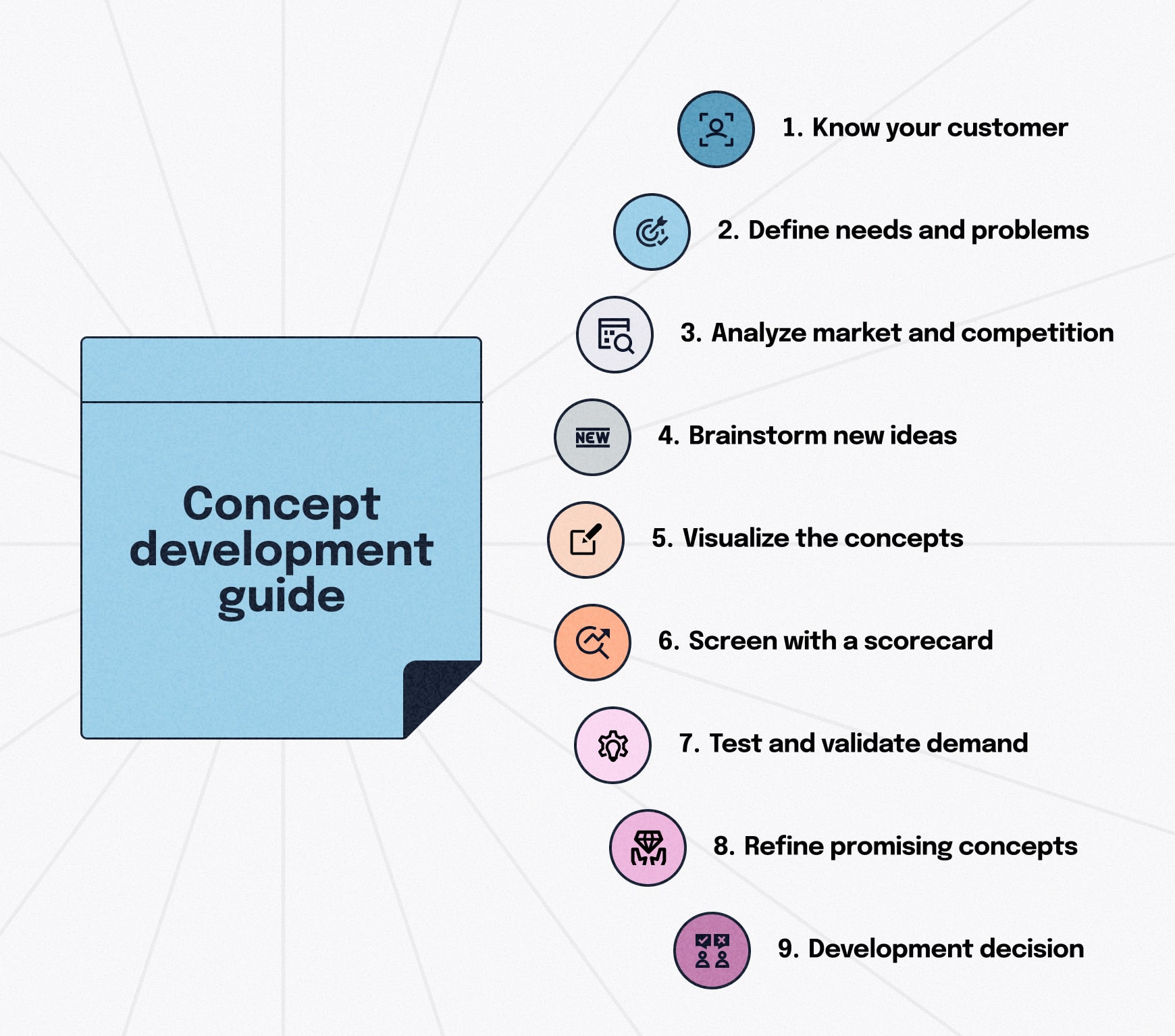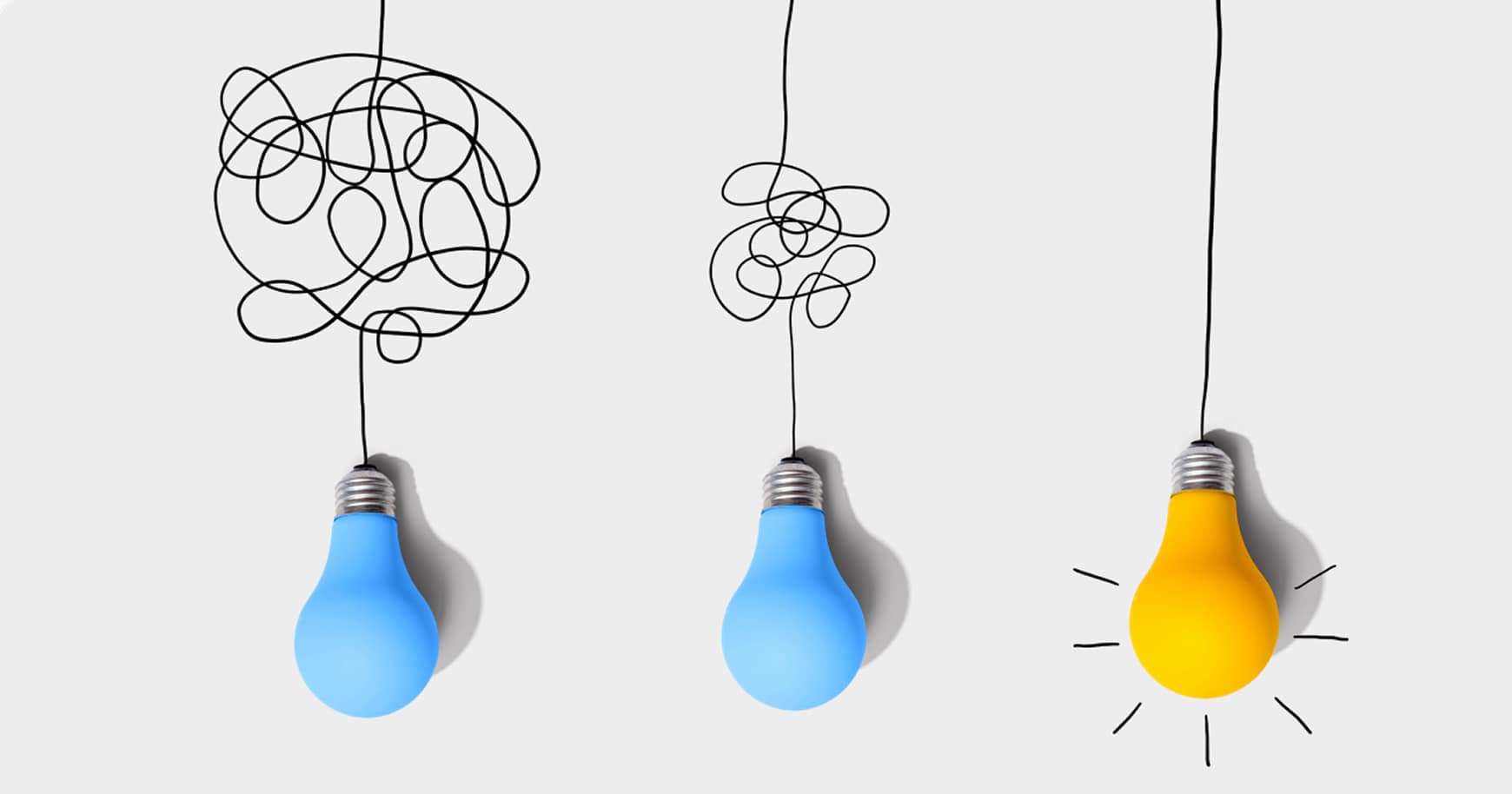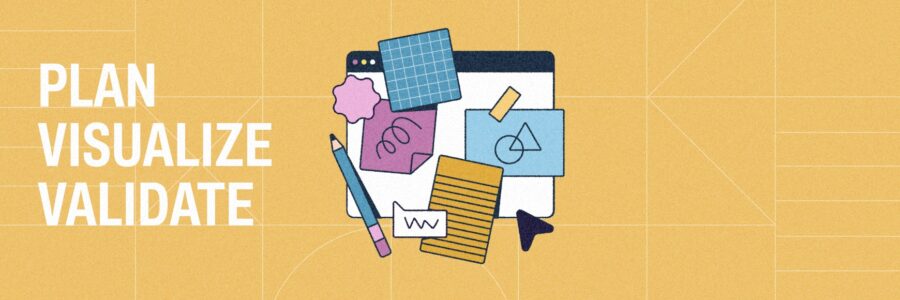The best products start with great ideas but the difference between a good idea and a successful one lies in strong concept development. When every feature feels tailor-made to solve a real problem, it’s not an accident — it’s the result of a deliberate process that identifies challenges, validates solutions and refines ideas into products people actually need.
Concept development is how teams pinpoint customer issues, generate solutions, and systematically build experiences that elevate both usability and value.
Great products aren’t born; they’re grown from tested, validated concepts.
Key takeaways
- Solve the right problem: Concept development is customer-focused, ensuring your solution (product, service or strategy) addresses a validated need or challenge or uncovers new opportunities — not just a cool idea.
- De-risk early and save money: Validate concepts quickly using a fail-fast approach to prevent costly rework.
- Lay the groundwork for planning: A market-tested concept becomes the foundation for your MVP, feature priorities and development roadmap.
What is concept development?
Concept development is the customer-focused process of identifying needs and challenges, then generating, testing and refining ideas to resolve them, generally with a product, service or strategy. Early validation minimizes risk, prevents costly rework, and helps teams prioritize features while planning a minimum viable product (MVP) and roadmap.
Put simply, it’s a structured approach to transform promising ideas into practical tools and solutions for your target market.
🎬 Learn what Slickplan can do!
We filmed a short video to show you exactly how to use Slickplan
Why the concept development process matters
Strong concept development and planning align ideas to genuine customer needs so you can build what people actually want. It’s the process of shaping a viable concept into a new offering, or refining an existing one, to clearly address those needs and challenges.
The 9-step concept development process

Most concepts aren’t ready for primetime the second they’re thought up; there’s an ideation process that takes something from an abstract idea to a product or service that’s ready for the market.
Use this concept development guide to work through that.
1. Understand your customer
Knowing your customer or user is a critical piece of the new product development process. Understanding who you’re solving for should guide all of your business decisions, not just concept development.
You may already have user or buyer personas and historical analytics to anchor needs and goals. If you’re just starting, develop those user personas and lean more heavily on market research in the beginning.
2. Identify customer needs and define the problem

Concept development is, in many ways, an exercise in problem solving. The better you know your customer, the more easily you can pinpoint their needs, pain points and desires, which will be your guide to solving their problems.
The way we learn all this is by gathering and listening to customer and user feedback. Use quick UX research methods like interviews, surveys or support logs to validate the problem before you explore solutions. That validation de-risks the development of a product before you commit resources.
Then go deeper with market and customer research to gather insights and data about preferences. From there, define the problem your service or product idea aims to solve and the requirements potential customers and users have.
You could also create a Venn diagram to see the overlap between customer needs, business goals, and market opportunity.
3. Market and competition analysis (SWOT)

Developing a new product or service comes with a price, in terms of both time and resources. If your addressable market is small, building something out fully may not be worth it, especially for a physical product where manufacturing costs can rise quickly.
It’s therefore important to estimate market size, identify primary segments and map competitors. A simple SWOT (strengths, weaknesses, opportunities, threats) or competitor matrix will reveal gaps, must-have features, market trends and places to differentiate before you build.
This market scan informs concept and development choices instead of building on assumptions.
These early-stage steps are where you narrow your scope and get your team looking through the lens of a specific problem that addresses a specific customer; the concepts you outline should fall within those bounds. They bring clarity and sharpen the next part of the concept development process: generating concepts.
🧠 Keep this in mind: It’s not necessarily a problem if the big idea you’re developing already exists; you’ll just have to differentiate yours. Cell phones existed before Apple launched the iPhone and that worked out pretty well.
4. Brainstorm and generate concepts

This is where the magic happens, where you channel that foundational research into generating as many ideas as possible.
What techniques can help get you into creative thinking mode and come up with new ideas?
- Workshops
- Mind mapping
- Customer feedback
- Talking to stakeholders
- Brainstorm with your team
- Random ideas that pop up in the shower
There’s no one-size-fits-all approach to idea generation; no set way to build a concept. Have brainstorming sessions where you can discuss freely, bounce ideas around and get different perspectives, allowing your concepts to grow wings and take flight.
The more diverse the voices, the more innovative ideas and interesting concepts you’re likely to come up with, increasing the odds of there being a gem among them. Invite or create a cross-functional group so feasibility, desirability and viability are represented in ideation from the start. Here are typical roles to consider for each lens:
- Desirability: UX researcher, UX/UI designer, content
- Feasibility: Engineering lead, architect, data/ML, QA
- Viability: Product manager, finance/ops, marketing, sales, legal/compliance
At this stage, include:
- Benefits
- Features
- Usability
- Price point
- Functionality
- Implementation
- Value proposition
- Where it fits in the user journey
- Resources required for development
💡Slick tip: Remember to ideate and define from the customer’s perspective. Just because you think something is cool doesn’t mean your users need or want it.
How many concepts should you come up with?
There’s no set rule, but a target like 10 well-defined ideas forces you to explore wider before going deeper, reducing the temptation to lock onto early favorites and giving you enough variety to compare on a scorecard without overwhelming everyone.
In small teams, a 7–12 range hits the sweet spot for concept diversity without ideation fatigue.
5. Visualize the concepts

Visualizing the concepts you generated is key to understanding their viability and if they’re likely to work as you envisioned.
Seeing your ideas also makes trade-offs real.
Sure, you can put pen to paper and draw them all out, but with multiple concepts, that can be a pain. You might end up with 10 napkin sketches that are tough to share and even tougher to edit. Not exactly the ideal method.
Digital tools make this step easier and far more collaborative.
Use our Diagram Maker to turn ideas into shareable concept maps that inform planning and centralize stakeholder reviews. Create simple process mapping and/or swimlane diagrams to show ownership, handoffs and what changes between teams.
6. Concept screening with a simple scorecard
This is where you’ll identify the most promising ideas. Screening your concepts means comparing them to the problem you defined earlier and the user’s needs.
For consistency, assess each concept using predefined criteria and ranking metrics.
The following are pretty standard:
- Convenience
- Usability
- Quality
- Functionality
- Performance
- Price
- Value
- Experience
Whatever you decide to use as your criteria, keep it consistent by developing a simple scorecard or using something like a Pugh Matrix.
Want to evaluate your own ideas?
Use our interactive Concept Screening Scorecard to compare projects by desirability, feasibility, viability and risk.
Open it in Google Sheets, then go to File → Make a copy to save your own editable version. Once copied, all formulas and scoring features will work automatically in your Drive.
Use the concept scorecard template
It goes without saying that not all ideas will turn into successful products. This step is where you synthesize feedback and whittle concepts down to the ones you plan to pursue.
Don’t toss the others though, a nugget of a good idea in one concept can be incorporated into a new concept down the road.
7. Test concepts and validate demand
Run small, quick tests with target users and customers. Combine short surveys, interviews or rough prototypes to confirm signals like demand, must-have features and price tolerance.
Compare options with your scorecard and drop what doesn’t clear the bar. The goal is simple — to qualify concepts people will genuinely want and are willing to pay for.
Use this testing phase to answer questions like:
- Are the features useful?
- Does the price work?
- How do we differentiate from a similar alternative?
- Is there real interest?
- Is something missing?
You can further screen your concepts by factoring in the assessments and information they provide.
8. Refine the concepts
With testing and feedback in hand, it’s time to get back to the drawing board to refine, enhance and iterate the concepts.
There’s nothing complex here, just apply what you’ve learned to strengthen the concepts that show real potential to become innovative solutions. Document what changed and why, so learning carries into planning and building.
9. Development decision

After going through the entire concept development process, you’ve reached the moment of truth:
Is there an option among your concepts that warrants development?
Look back at the problem you defined and your customer or user’s needs. Go through your screening criteria again. Check your refined concept against your business strategy, taking into account addressable market size, target audience, competition, pricing and commercial viability.
Be thorough and methodical as you evaluate every angle. Consider these as starting points:
- Profit potential
- Market potential
- Is it intuitive to use
- Cost and time to implement
- Level of importance to users
- Alignment with business strategy
- Will customers or users find it valuable
- Skills and capabilities your team may need to add
It’s better to spend extra time on this part of the concept development process than rush through only to realize you’re developing a product or service that isn’t quite right.
Do an impact analysis before you greenlight the concept and development of a product, assessing the ripple effects on ops, support, training and systems.
Look at the impact on your current product lineup and brand. Confirm the upside outweighs the internal lift and external risk. If needed, create a prototype for user testing with a small group to validate; it’s a cost-effective way to get valuable, real-world feedback.
💡Slick tip: Use a "fail-fast" approach throughout the concept development journey. Fail-fast means that once you’ve identified something isn’t going to work, immediately stop developing that concept. If an idea isn’t going to generate value or solve a problem adequately, it’s best to save time and money and focus on an idea that will.
Concept development examples
Every finished product on the market started as just a concept. Only through refinement and iteration did those ideas become ready for launch.
Here are a couple of examples of concept development.
Uber

The concept was deceptively simple — push a button, get a ride.
The idea was born when the co-founders just couldn’t find a taxi one snowy night in Paris. A problem in need of a solution.
They thought, "What if you could hail a ride from wherever you are from your cell phone?"
After workshopping the idea, UberCab.com was born offering one thing: a black luxury car, which they tested in New York.
With the concept being proven, they changed the name to just Uber. It wasn’t until a few years later that they launched UberX, another concept, the affordable option we all know today.
Today, Uber offers additional services that also began as concepts, from food delivery to split fares, evolving far beyond its original form and becoming such a success that "Uber" is now a verb.
Super Soaker

Concept development stretches across all categories of products and businesses; toys are no exception.
How the Super Soaker came to be shows that successful ideas can come from anywhere.
Dr. Lonnie Johnson — a literal rocket scientist who worked on the Galileo spacecraft — came up with the concept for an epic squirt gun while experimenting with a heat pump design.
The aha moment came entirely by accident when the pump he was working on sprang a leak and shot a stream of water clear across the room.
He quickly got to work on producing a prototype from PVC pipes, a soda bottle for holding the water, etc. – a prototype he still has.

This was in 1982.
He applied for a patent in 1983, which he received in 1986, and the Super Soaker finally hit the shelves in 1990 as the "Power Drencher" before rebranding in 1991.
It took nearly a decade of dedication, a reminder that great ideas need time to develop and that, in product development, patience is a true virtue.
Shape ideas into solutions with concept development and planning
Great products, software and services aren’t created by accident; the seed of an idea has to be nurtured and developed before it’s ready. Concept development is the process that validates the initial spark of an idea, putting you on the pathway to creating an innovative solution.
Get started with a concept map template and use Slickplan’s Diagram Maker to bring clarity to your ideas and real value to your users.
Think visually. Improve UX with Slickplan
Build intuitive user flows, stronger customer journeys and improve information architecture.
Frequently asked questions
Why is concept development important?
It aligns ideas to real needs, cuts risk early, and prevents wasted build cycles. Clear concepts sharpen value propositions, inform pricing and positioning and accelerate planning by clarifying what ships first. Teams move faster when they agree on the problem, the audience, and the minimum set of features.
What are the steps in concept development?
Typical steps include understanding customers, defining the problem, analyzing the market and competitors, brainstorming ideas, visualizing concepts, screening with criteria, testing with users, refining and making a development decision with an MVP plan and short-term roadmap.
How does concept development fit into the development of a product?
Concept development comes early. It clarifies the problem, customer, value proposition and key features. By testing assumptions before design and development, you minimize rework and avoid overbuilding. A strong concept becomes the basis for an MVP, backlog and roadmap that guide the rest of development.
How do you validate a product concept?
Test with the intended audience. Use short surveys, interviews and low-fidelity prototypes to confirm demand, must-have features and pricing tolerance. Compare options using a simple scorecard, then refine or drop ideas that don't meet goals. Keep tests small, fast and focused on decisions.






 X
X

![What is a decision tree? [Practical examples & use cases 2026]](https://cdn-proxy.slickplan.com/wp-content/uploads/2023/08/Decision_tree_cover-570x190.png)